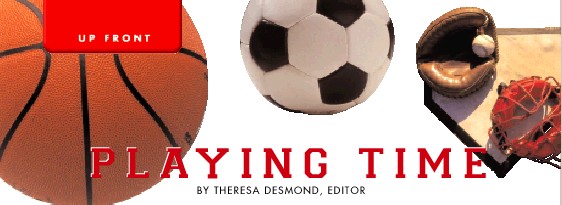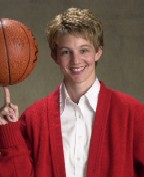| Vol.
13. No. 1 |
Summer
2003 |

| In
a television ad running during the NCAA basketball tournament in March,
an actor’s voice announced that the women’s tournament
was all about six—the six tournament wins it takes to become
the NCAA champion. “It’s not about Title IX,” the
voice said. “It’s about six.”
I’m not so sure. I think it’s about six and about Title IX, the 1972 law that bans gender discrimination at institutions receiving federal funds. Though I think the ad was intended to be positive—to overcome the stigma many still place on Title IX as a policy of favoritism by positioning the women’s tournament, like the men’s, as simply a competitive series of games won by skill—it’s disappointing to see that a stigma is still perceived, even by the tournament itself. I’m not an expert on Title IX, but, like most people, I have seen the improvements in women’s athletic opportunities—from scholarships to facilities—because of Title IX. As John Youngren’s BA’88 article on p. 10 notes, today more women around the country are participating in college sports than ever before—a tenfold increase since the late ’60s. While the process of change may continue to be uncomfortable for some, access to all has improved, and, in a college setting, it seems that access ought to be a primary consideration. Just ask Mikki Kane-Barton BS’94. Kane-Barton was a standout U of U athlete in two sports, basketball and volleyball. Her record-setting performances in both sports earned her election to the Crimson Club Hall of Fame this year, along with swimmer Shawn Rowland BS’89, gymnast Diane Ellingson Smith BS’84, and tennis player Rick Warner BS’45. Kane-Barton grew up
playing several sports—her father was her high school basketball
coach—but didn’t even know about the U’s volleyball
program until she got to campus as a basketball recruit. Today,
she’s thrilled to see the progress
the volleyball team has made since she played in the early ’90s—“They’re
nationally ranked!”—and credits the increased attention
given women’s sports through Title IX. |
Kane-Barton and husband Paul BS’93, a former Ute football and baseball player, have three children, and, says Kane-Barton, “I want those opportunities to play sports to be available for them”—especially her daughter. “I think it’s a shame that women sometimes aren’t encouraged to be physical,” she says. “My dad called our team the ‘Lady Tigers.’ But he always said we were to be ladies first. It might sound traditional, but I think we should celebrate being women. We’re athletic, graceful, and strong.” Today, Kane-Barton remembers her experience at the U as entirely positive. “The influence of all the people I met—coaches, players, administrators—is still with me. The teamwork I learned was a much more valuable skill than the physical skills, which, I hate to tell you, go as you get older. “When you make opportunities to participate in sports available, nothing negative can come from it,” she adds. “The money spent is nothing compared to what you do for people. I’m a better person because of my experiences at the U.” In turn, the U and the
entire Utah community have benefited from the talents—athletic
and academic—that Kane-Barton and her Hall of Fame companions
have contributed. (Former gymnast Diane Ellingson Smith, for example,
has reached thousands as a teacher and motivational speaker, drawing
on her experiences in dealing with a post-college spine fracture
that left her paralyzed from the chest down.) Their educational
opportunity depended on a vision of college athletics as just one
part of the education of the whole person. And their achievements
are a reminder of what can happen when universities are willing
to manage the tricky business of increasing access. |

 “Even
one great opportunity is better than nothing,” she says. “There
are a lot of girls out there who are very talented, and I think
they add a different dynamic to sports.”
“Even
one great opportunity is better than nothing,” she says. “There
are a lot of girls out there who are very talented, and I think
they add a different dynamic to sports.”